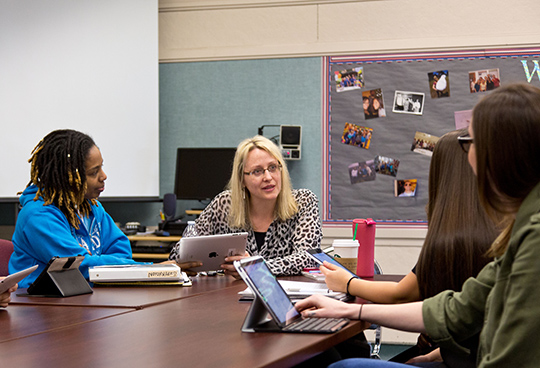
Elisabeth Esmiol-Wilson, PhD, LMFT
Department of Marriage and Family Therapy
Preparing Clinicians Using Feedback Informed Treatment Tools

Elisabeth Esmiol Wilson is an Assistant Professor and Director of Clinical Training in the Department of Marriage and Family Therapy. Her role in PLU’s MFT Department includes teaching graduate courses, supervising students’ clinical work in the onsite Couple and Family Therapy Center (CFTC), and overseeing students’ transitions to offsite internship sites. Elisabeth is passionate about training students to be clinicians. Because therapy is based on a confidential relationship between clinician and client, most clinicians are never observed or given direct feedback once they graduate. Elisabeth believes one of the best ways to both learn and practice therapy involves directly asking clients for feedback. Using cutting-edge research and technology, Elisabeth is helping make client feedback a regular part of training for PLU’s MFT students.
What is one instructional technique or project that is particularly effective, innovative, or engaging?
“The innovative instruction technique I brought to our PLU MFT department is called Feedback Informed Treatment and is an evidence based practice that highlights therapeutic rapport, or a clinician’s relational connection with clients, over any particular therapy model. This is particularly interesting because while our program and most MFT programs focus on training students in different therapeutic modalities, research indicates that having a strong therapeutic rapport with clients is more significant that what particular model a clinician uses. Feedback Informed Treatment works by having clinicians track therapeutic progress and ask their clients directly for feedback at the end of every therapy session. This is a big deal for clinicians in training who are already nervous about how they are doing in the therapy room. Asking for and responding effectively to client feedback can take a lot of courage and self-awareness. To help our students in this process, we focus on creating a culture of feedback that supports a learning environment in which it is okay to make and learn from our mistakes. Additionally we have invested in an online program called MyOutcomes and purchased iPads which our students use to track therapeutic progress at the beginning of every therapy session and administer the feedback survey at the end of every session. Students hand the iPads to their clients at the beginning and end of every session, MyOutcomes then records and graphs the results, and finally clinical supervisors can review student progress and discuss their clinical work during supervision. Our MFT department now teaches our graduate clinicians how to use Feedback Informed Treatment before they start their practicum sequence, so that our students can integrate it with ALL their clients across all their theory classes, and discuss their developing therapeutic rapport during their practicum sequence.”
Dr. Elisabeth Esmiol Wilson discusses using iPads to create a culture of feedback in the Marriage and Family Therapy program at PLU.
What related tool or strategy do you use that other PLU faculty might like to try in their courses?
“The strategy of intentionally creating a culture of feedback in which mistakes are normalized and utilized in the learning process is beginning to transform our program. Once we begin to see mistakes as an opportunity for growth, asking for feedback becomes a regular and much less frightening prospect. Rather than basing performance on “getting it right the first time,” students are encouraged to discard notions of perfectionism and embrace the learning process. Additionally, faculty model this culture of feedback by regularly inviting feedback from students, for example in our Practicum courses, we invite our students to fill out regular feedback forms at the end of each supervision session in which they give faculty feedback about the degree to which their learning needs were met.”
What are the benefits, for you and your students, of utilizing this tool or strategy?
“One of the most amazing benefits of integrating regular client feedback into our clinical training program is that students are able to immediately repair ruptures with their clients and decrease dropout rates. For example, at the end of a therapy session, one of our students provides a client with an iPad and asks the person to fill out the brief feedback questionnaire. The student then notices that the client gave her a low mark for the question on “feeling heard and respected and understood” or the question on “getting to talk about and work on what you wanted to talk about and work on.” Immediately the student asks the client how she could have respected and understood the client better, or asks the client about what they didn’t get to talk about that session. Now the student is able to connect with the client as she thanks the client for this important information, owns how she didn’t understand a particular issue or discuss an important topic, and then reassures the client that she will focus on this their next session. By making sure that the client didn’t leave before sharing this important information and that the student had the opportunity to address the client’s feedback, research shows that the therapeutic relationship actually becomes stronger than if the student hadn’t made the mistake in the first place. Amazingly, when we use feedback to repair a relationship, the relationship can actually become stronger than if there had never been a rupture.”
What advice would you have for someone interested in trying this tool or strategy?
“I’d be curious how different disciplines could find a way to integrate a culture of feedback into their coursework, focusing on mutual practices of feedback in which students both give and receive feedback.”



